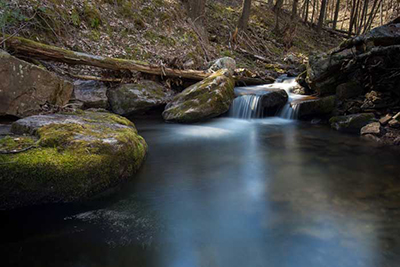
In the jagged Allegheny Mountains that straddle West Virginia and Virginia, a stream rises and winds north over 100 miles to become the mighty Potomac River, which curls past the nation’s capital before dropping to the Chesapeake Bay.
But near its headwaters, that stream is quiet. The South Branch slides between ridges and through forest and field hiding boulders beneath their green. It’s here, south of Franklin, West Virginia, where Sue Mitchell’s family has farmed for more than 100 years. The property was divided from a large land grant awarded to her ancestors following the Revolutionary War.
Now, it’s their vacation spot. Mitchell and her husband, Ralph, often sit on the front porch of their mobile home. The river murmurs to them as it cascades downhill.
For Sue Mitchell, 70, it’s a sound she has known nearly all her life. She grew up coming to this part of the family’s property, sneaking away from her grandparents for summer sleepovers with her aunt and uncle in their log home. The old home remains, a reminder of those happy times.
Over the past decade Mitchell watched as the South Branch stole chunks of her family’s 345-acre farm as it rushed downhill, shrinking the pastures surrounding the old log home—threatening to wash away some of those memories, too.
But then Dustin Wichterman from Trout Unlimited (TU) started coming around. With the help of the Natural Resources Conservation Service and the U.S. Fish and Wildlife Service (Service), Wichterman and the Mitchells now have healthier cattle and a cleaner stream. Equally important: the land on which the family expects to hold many future gatherings no longer is washing away.
Wichterman came to first look at the site five years ago. What he saw looked familiar, a problem that plagues landowners across the Potomac headwaters.
“They had an eight-foot-concave bank that was eroding annually like three to four feet, just dropping hundreds of tons of sediment into this stream,” said Wichterman, coordinator of TU’s Potomac Headwaters Home Rivers Initiative.
“That’s my selling point a lot of times for these farmers,” he said. “They’re watching topsoil come off their fields and watching the river change in ways that are undesirable for the fish and farmers.”
What’s an organization that promotes trout got to do with farms and cows? The Upper Potomac is a destination for anglers throughout the East. The mountains shelter several native brook trout fisheries. The hilly, tree-dotted terrain is perfect for trout. The fish need cool, clean water; the cover of trees along the banks ensures the right temperatures for the fish to thrive, while plants and shrubs bordering the streams filter water.
But many of these cold-water creeks have taken a beating—from severe flooding, from development and from well-intentioned people who “fix” the river by bulldozing the channels. Timber harvests and agriculture, if not practiced properly, can add to the problem. The result is an unnaturally wide channel, steep eroding banks that drop into the water, and overly warm water — not the habitat a trout likes.
The solution?
“What we attempt to do is to work from the top of the watershed downstream,” Wichterman said. “If you don’t fix it up top you can’t fix it down below.”

First step: manage the cattle. The “conservation crew” — workers from TU and the Service — pounded posts and strung 7,000 feet of high-tensile electrified wire fencing to keep the cows away from stream banks.
The fencing protects just over a mile of spring-fed brook trout stream and a half mile of the South Branch, as well as more than 50 acres along the stream edge. It also enables the farmer to manage the herd a little more efficiently, letting grass grow up in some paddocks while cattle mow down the pasture in others. The team tapped into a well and an off-stream spring to supply the cows with cleaner water. They now drink from two troughs.
Second step: restore the stream. The Mitchells offered up trees and boulders to help return the stream to a more natural state. Wichterman estimates that gesture was worth $14,000. The crew used those natural resources to return the stream to a narrow channel with deeper pools for the cold, clean-water-loving trout. They planted red and sugar maple, American sycamore, white and red oak, and other plants whose roots will eventually hold the streambank in place.
The boulders — 100 tons worth — became a fish-friendly stream crossing that can accommodate off-road vehicles. The crew built it at the existing grade of the stream bed. When the water is low, a truck or other vehicle can easily bounce over the rocks from one stream side to the other.
The Mitchells put the crew up in their vacation home and kept them fed. Ralph Mitchell, said his wife, “rolled up his sleeves and helped out.”
“Landowners don’t all have $60,000 to put into a restoration project, but they always have in-kind support—blood, sweat, tears, rocks and logs,” Wichterman said. “We come with an open approach, see how much the landowners can put in, are willing to put in, and we assist where needed to achieve the maximum conservation benefit for every dollar we put in. Every landowner has some skin in the project.”
Such a job takes coordination. Working together, TU, NRCS and the Service took care of the project’s paperwork, conservation planning, construction and monitoring. The Mitchells’ project has had ramifications downstream, too. Three comparable stream-improvement plans are in the works since the Mitchells focused their attention on the South Branch, Wichterman said.
“The Mitchells are honestly an important link in establishing the hubs of conservation—starting at the top of the watershed and building this line of projects downstream,” Wichterman said.
Across the Potomac headwaters, the partnership has completed 14 miles of in-stream restoration and has protected and restored more than 400 acres of riparian habitat to the benefit of 30 miles of streams and rivers. The organizations also have reconnected more than 20 miles of headwaters by replacing five undersized culverts and low-water bridges that blocked fish.
Statewide, the crew has installed more than 2 million feet of fencing to improve herd and stream health across West Virginia, said the Service’s West Virginia supervisor, John Schmidt.
“We are helping the farmer manage his land and stream in such a way that it remains profitable for the land to remain in agriculture,” he said. “This is good for water quality, fish, and wildlife and the folks that enjoy them.”
“Oh, and the trout love it,” he added.
Yes, they do. Back at the Mitchells, the restored section of stream now holds more trout, to the pleasure of Mitchell’s children—Greg, Jeanette and Rhonda—and their families. The forest and field oasis provides ample places to hunt deer and turkey, search for mushrooms, and ride four-wheelers.
It’s more than just having a place to visit, Greg Mitchell believes.
“The goal is to leave things better than when you got it,” said Mitchell, who helps other farmers as a branch manager for Farm Credit of the Virginias, a cooperative lending institution.
“It’s a goal of a lot of the farmers around here,” he said. “A lot of them do take pride in improving their farms and doing practices to make it better for the cattle and other different types of livestock.
“You get a sense of accomplishment by making farms better than what they are when you come along,” he said.
And in this case, a better South Branch, too.
 Sign In
Sign In
 Sign In
Sign In
